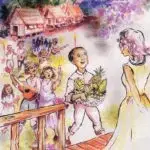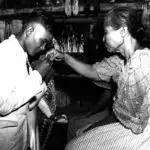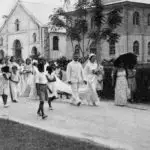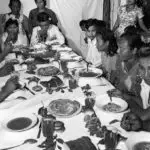Dowry Presentation: Marriage Rituals




Table of Contents
Share This
Marriage rites: Dowry, wedding, and celebrations
On the night before a wedding in ancient Guam, the two families met to present the chenchule’ (ceremonial gifts) to the mother of the groom. They brought edible roots (yam and taro), breadfruit, bananas, rice, fish, salt and betel nut.
In the evening, betel nut was passed around and supper served, and there was dancing. At daybreak the relatives of the groom, leaving a few individuals at his mother’s home to prepare dinner, went to the girl’s house and were given betel nut. Here the bride was given to her husband.
Breakfast was served on a mat placed on the floor at the bride’s home. The relatives of the groom were served first, in order of rank. After breakfast, the wedding guests went to the house of the groom, where dinner was served, the bride’s relatives taking precedence.
Once the Spanish colonized the Marianas, Catholic traditions were incorporated into the wedding rites. One woman, Concepcion Fejeran Garrido, recalled the following, a typical southern wedding in pre- and post-war Guam.
Presentation of gifts
About a week before the wedding the groom’s family formally presented a wooden chest of gifts to the bride. The gifts included a wedding dress, an evening dress, wedding rings, the shoes for the pre-wedding and wedding, and other items such as lotion and perfume. Aside from the chest of gifts, a dowry was given to the bride. The dowry might include a Chamorro style gold necklace, earrings and a bracelet made by the only goldsmith jeweler on Guam at the time. These were presented in a jewelry box along with as much as $1,000 as a wedding gift. Gifts were also presented to the parents of the bride such as firewood, suni (taro), dågu (yam), pugas (rice) and binådu (deer meat) and pugua’ (betel nut).
Kombiti: The groom’s party
The pre-wedding party, known as kombiti (guests; sometimes called “fandånggo” in the Spanish era), was put together by the groom’s family. A representative escorted the bride, dressed in the gown provided by the groom’s family, to the party from the groom’s family. The groom greeted her as she arrived and the two entered the party through a decorated arch where the guests showered them with flower petals. The bride and her family stayed only long enough to enjoy the dinner, listening to speeches and toasts for the occasion made by their friends and family.
The komplimento
After the bride and her family returned from the kombiti, the bride changed and prepared for the komplimento. The komplimento was a traditional event made to honor the bride and the groom for abiding by the conditions made by the bride’s father during their engagement. They were rewarded for not being seen in public together and for not showing any display of affection toward each other, as their good behavior had brought honor to their family.
About two hours after the bride’s family left the kombiti, the groom and his family walked from the party to the bride’s house, singing while they walked. They stopped about twenty yards in front of the bride’s house where they carried their best pugua’, pupulu, tuba, åfok and tobacco and homemade whiskey. A female relative of the groom, usually a cousin, would bring a bouquet of flowers for the bride for the wedding.
As they neared the house, one of the groom’s relatives called out, “Amaga’, Amaga’, huyong ya ta afana’. Kao guahu bai guagua-tu pat hågu un ma-maila.” (Noble One, Noble One, come out and we will face each other.)
During this part of the ceremony, they rhymed their statements.
The bride’s relatives replied, saying “Hågu un ma-maila. Ha-la’mi magi.” (You come over.)
Before they went over, the groom’s relatives asked, “Amaga’, Amaga’, kao guaha lupok para bai poddong? Pat guaha tituka’ para bai tinika’un?” (Noble One, Noble One, Are there any holes I am going fall into? Or are there any thorns I am going to step into?)
The bride’s relatives replied, saying, “Ha-la’mi magi, taya lupok para un poddong, taya tituka para tinika’un. Sa’ esta munhayan hu faisa’un.” (Come over. There are no holes and no thorns. I already cleaned the way.)
The groom’s family said, “Esta gua’ot para un ga’cha, esta potta para un halom. Esta bangku para un fatatsong, esta chupa’ yan mama’un.” (Here are the steps you will step up on, the door you will come into. Here is the bench you will sit on and the cigarettes, pugua’, pupulu and afok for you.)
The groom’s family then walked up the steps to the house and entered the living room The groom’s cousins then kissed the bride and gave her the bouquet. The groom’s relatives said, “Maga’, maga’ gagao todu i malago-mu, sa todu hao bai na’i. Sa maseha dikiki na taotao, lao dangkulo na maga’låhi.” (Noble One, Noble One, ask for what you want and I will give it to you. Although I may look like a small and humble man, I am a strong provider.)
The bride’s relatives responded, saying, “I hu gagagao na agun, ti sinifan pat tinampi. Ayu hu gagagao na agun, i mato’tu yan matafye.” (I am not asking for that which has been peeled and boiled (dågu). What I am asking for is that which has been picked and threshed (rice). The groom’s family then repeated their previous statement and the bride’s relative responded, “I hu gagagao na totche, ti pineksai’ yan pinaki. Ayu hu gagagao na totche I masugon ginen tati ya a’gagang kumate.” (I am not asking for the meat that is raised and shot. I am asking for the meat that is chased out of the jungle and cries out loud (binadu).)
All of the items requested were already given during the presentation of gifts a few nights before. The groom’s relatives repeated their previous statement and the bride’s relatives responded, saying, “I hu gagagao na gimen, ni tinilipuk pat finakti. Ayu hu gagagao na gimen i malalagu gi guafi.” (I am not asking for the drink that is pulled out of the well or caught from the rain. I am asking for the drink that runs through the fire (aguayiente).)
The groom’s family then gave the aguayiente in a glass but the bride’s relative slapped it out of his had and said, “Mungga yu man ha gimen gi basu, sa guahu ti taotao lagu. Ayu bai gimen i chireta pat i tabu.” (I don’t want to drink from the glass because I am not an outsider. I want to drink out of a bamboo cup or a coconut shell.)
After this formal welcoming, the bride’s relatives invited the groom’s relatives to start the party saying, “Ta fan boka, ta fan gimen, ta fanangta. Ya ti ta fan makpo’ pa’go esta agupa yan manana.” (We will eat, we will drink and we will sing. And we won’t be done until tomorrow morning).
Then music began and for the first time the bride and groom danced together. This dance was the first time they were allowed to show affection without disapproval. It was their reward from refraining from temptation of being together until this day. At this time, the bride and the groom’s families joined the celebration by competing on who had the best pugua’, pupulu, åfok, tobacco, tuba and whiskey. They ate and danced and celebrated until 11 p.m. or so at which time they had to depart to prepare for the following day’s wedding ceremony.
The wedding
Many Catholic churches only performed wedding ceremonies at the 5:30 am Mass. Therefore the bride had to be up at 3 am to beginning readying herself. She showered and dressed only in her panties. When she was ready, the groom’s aunt arrived to dress her, fix her hair and apply her make up. As awkward as this was, it was a part of Chamorro tradition and the bride had to abide by it. The parents were dressing at this time too.
Before leaving for the church, the bride and her parents prayed together in front of an image of the Blessed Virgin Mary in their home. The father of the bride offered his daughter to the Blessed Virgin asking that she help the young woman be a good wife and mother to her children.
The groom’s family sent someone to pick the bride and her parents up and take them to the church. The bride’s maids and groom’s ushers were at the church waiting. The bride’s father walked her down the aisle and presented her to her husband. A traditional Catholic wedding ceremony then took place at the altar.
For the Communion preparation the bride’s sister (or another female relative) put on a belo, or white cloth, over the bride’s head and the groom’s shoulders. At the end of the wedding mass celebration, the bride’s godmother or someone else (such as from the Sodality) walked the bride to the statue of the Virgin Mary and presented her bouquet and again asked for her help throughout the marriage. The choir traditionally sang “Hu Nå’i Hao” (a song honoring Santa Maria).
Before the bride and groom walked down the aisle as man and wife, the bride’s godmother and groom’s godfather signed the certificate of marriage from the Church and the ceremony ended with the seal of a kiss by the bride and groom.
Wedding celebrations
The bride and groom then drove to the bride’s wedding party. Upon arriving at the bride’s family’s house they would go into the living room, kneel on pillows and await the arrival of the elder relatives. When the elders arrived, the bride and the groom paid respect (manginge’) by smelling the hand of the elders who gave them their blessings and advice for a prosperous marriage.
Once respects were paid, the bride’s godmother opened and blessed the table and the party began. The bride and groom and their parents sat at a beautifully decorated table and were served their meal by the bridesmaids and ushers. After everyone had eaten, the bride’s relatives prepared food for the bride’s godmother to take home, which included a portion of everything presented on the table. Since the food was paid for by the godmother, it was a tradition for her to have a little of everything. The godmother was also entitled to take the top layer of the wedding cake.
After the bride’s party, the couple proceeded to the groom’s wedding party. The same traditional elements that occurred at the bride’s party occurred at the groom’s party. After the parties, the bride and groom went home and changed, then left to visit their sick and bed-ridden relatives as well as everyone who showed up to their parties that day. There they would manginge’ them and thank them for their blessings.
Contemporary Guam
While much has changed on Guam over the decades, some of these traditions still live on in various degrees by those who choose to follow them. Some people prefer a civil wedding or an American-style wedding.
For further reading
Flores, Judy S., ed. Kustumbren Chamoru: Chamorro Life Before and After World War II. Mangilao: University of Guam, 2004.
Freycinet, Louis Claude Desaulses de. An Account of the Corvette L’Uraine’s Sojourn at the Mariana Islands, 1819. Translated by Glynn Barratt. Saipan: Commonwealth of the Northern Mariana Islands Division of Historic Preservation, 2003.
